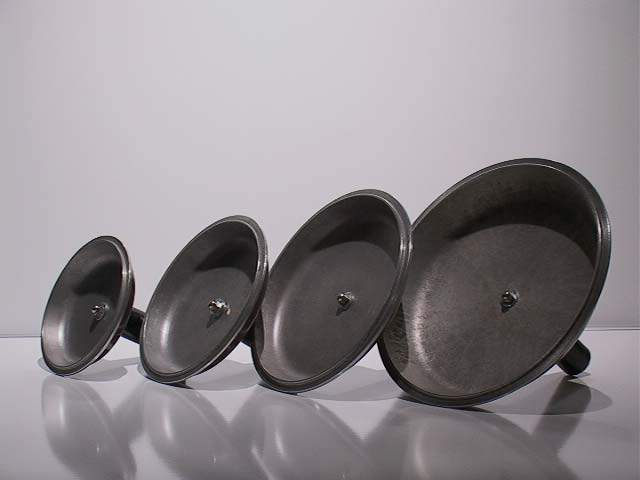The Instruments
 The
instruments are called "lydes", the
Danish word for "sound", and are simple pot lids attached to pine
doweling. Most are cast aluminum and collected from garage sales and
thrift stores in the United States. From examples
of Tibetan bells and Ben Franklin's Glass Harmonium I was well aware of
a continuous ringing method resulting from turning the edge of a bell,
but it wasn't
until I experienced a group headed by William Houck (Chico, CA)
at Mills College (Oakland, CA) that I realized the aesthetic
and educational potential from these found objects. Unbreakable
percussion instruments
for my school residencies! Inexpensive, available, un-tunable
instruments played best with inexpensive duct tape wound around
a stick! Because of an impending middle school residency, one back at my studio, I dug out the few of the lids
I already had (part of my scrapercussion materials), developed my own assembly
methods, and mallet and within a few years had a growing collection.
The notation presented here came from
the early school workshops in Tacoma without any I
Ching connection.
The
instruments are called "lydes", the
Danish word for "sound", and are simple pot lids attached to pine
doweling. Most are cast aluminum and collected from garage sales and
thrift stores in the United States. From examples
of Tibetan bells and Ben Franklin's Glass Harmonium I was well aware of
a continuous ringing method resulting from turning the edge of a bell,
but it wasn't
until I experienced a group headed by William Houck (Chico, CA)
at Mills College (Oakland, CA) that I realized the aesthetic
and educational potential from these found objects. Unbreakable
percussion instruments
for my school residencies! Inexpensive, available, un-tunable
instruments played best with inexpensive duct tape wound around
a stick! Because of an impending middle school residency, one back at my studio, I dug out the few of the lids
I already had (part of my scrapercussion materials), developed my own assembly
methods, and mallet and within a few years had a growing collection.
The notation presented here came from
the early school workshops in Tacoma without any I
Ching connection.
How They Work
Depending on the edge characteristics, a circular bell will provide a continuous ring if stroked at a specific speed, friction and pressure. For a mallet, duct
tape on 1-1/4" diameter pine doweling or 1-1/4"
PVC 7 inches long works well. As suggested by the notation,
I attached the bells to 1-1/4"
diameter pine dowels
5 inches long. These have a 1/4-20
hanger bolt inserted (drilled) into one end, a thick rubber washer to separate
the bell from the handle and then held snug with a small washer and a
cap
nut. Leather can
be used to cover the end of the 7" mallet, but a few layers of
smoothly layered duct tape works best with thicker layers
better suited to larger lydes.
To perform the lyde notation presented
here, a mallet wrapped on one end and not the other is best.
A suitable abrasive can be used to sand and smooth the outer rubbing
edge of the lydes making them
easier to play while diminishing surface noise. Smaller lydes
are easier to play if a small washer separates the rubber washer
from the bell itself. The instruments can be turned or struct at any point on the bell or handle being careful not to strike one bell with another.
The lydes
are noteworthy because of their ability to ring continuously and yet
their true richness lies
in their mobility, the wide variety of percussive
colors
available and the fact that you must accept
them for what they are, pot lids, and thus the imposition
of their fundamental pitch and overtones which can be almost as loud,
or louder at times, thanthe fundamental. For this reason pitch is not a
fixed parameter
in the notation. Every lyde
sounds excellently with every other lyde without exception. There are no wrong notes.
Depending on the acoustics of the playing space, the random combinations
of overtones using one or many lydes
will mix to buzz, gnaw and glisten in extraordinary ways. Listeners, who may otherwise detest new and experimental music,
often and without hesitation will accept these sounds as
beautiful music and even participate in developing new compositions
as if their prejudices had never existed. Part of the reason for
this, I believe, is that the lydes
are familiar objects, playful and easily anthropomorphized and, therefore, exempted from all that hard-to-reach
new music. But experimental music it is and these
instruments have great potential for opening the ears, minds
and creativity of others and are thus especially socially constructive.
Site Index
© Dan Senn 2018, BMI